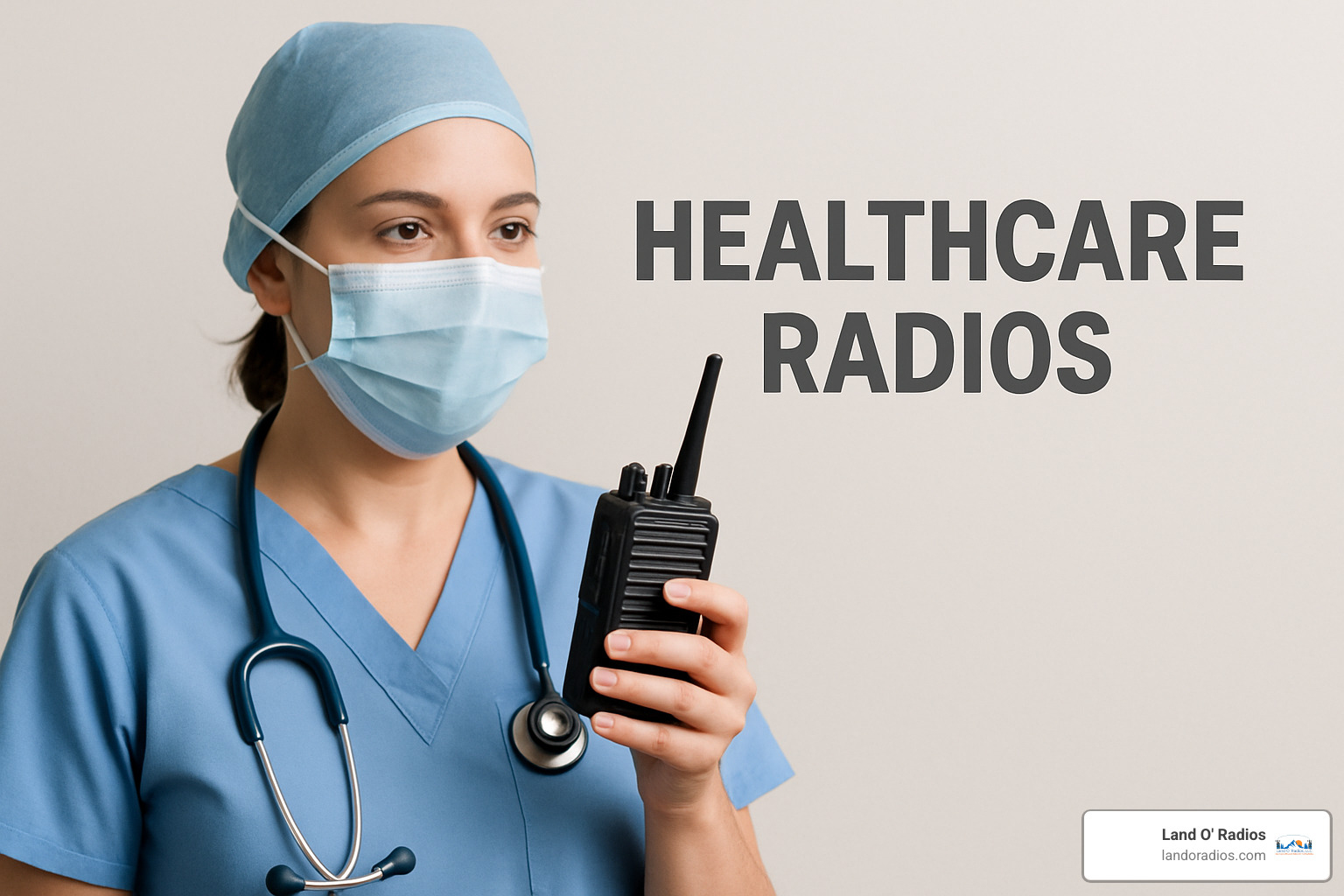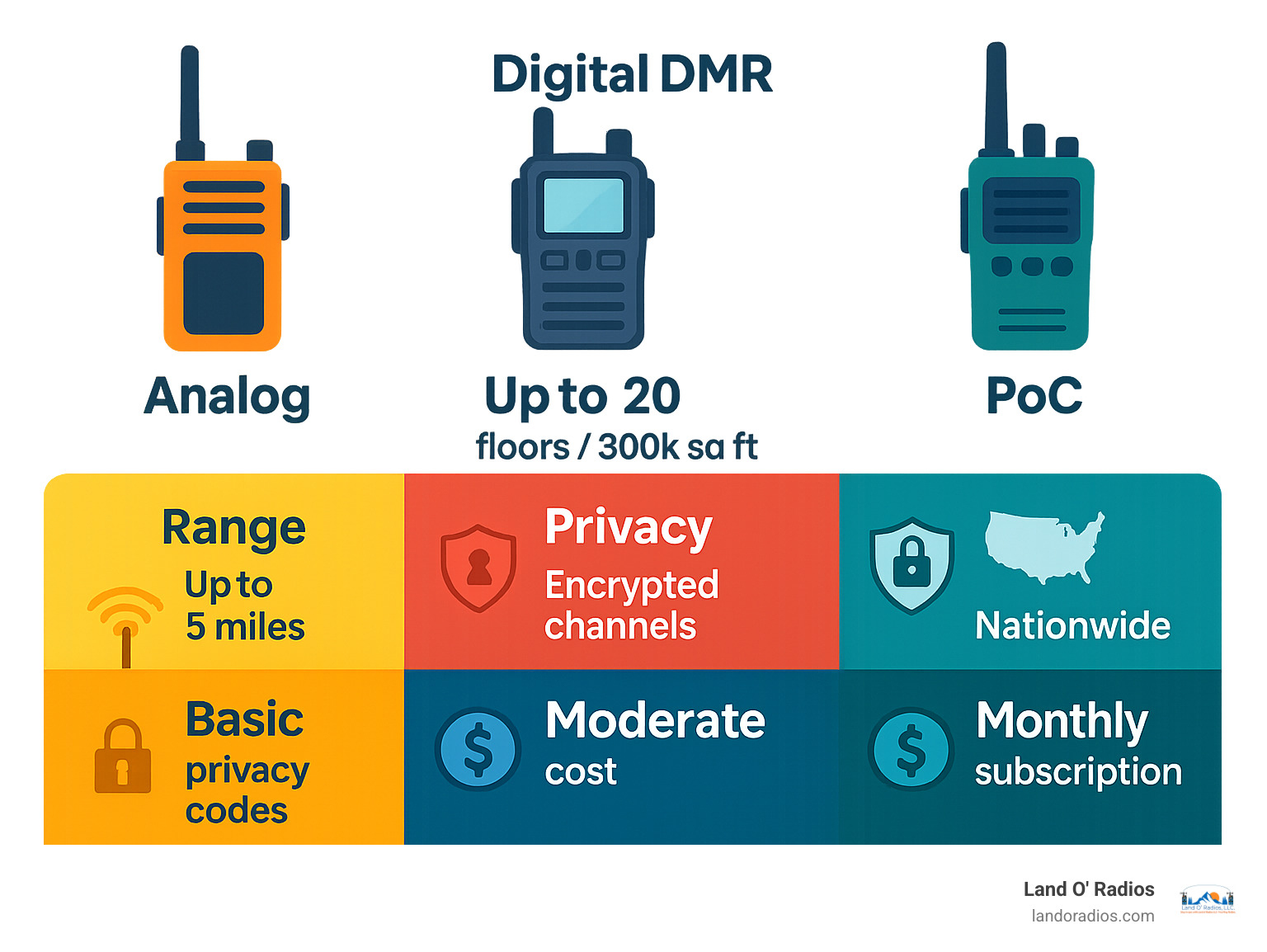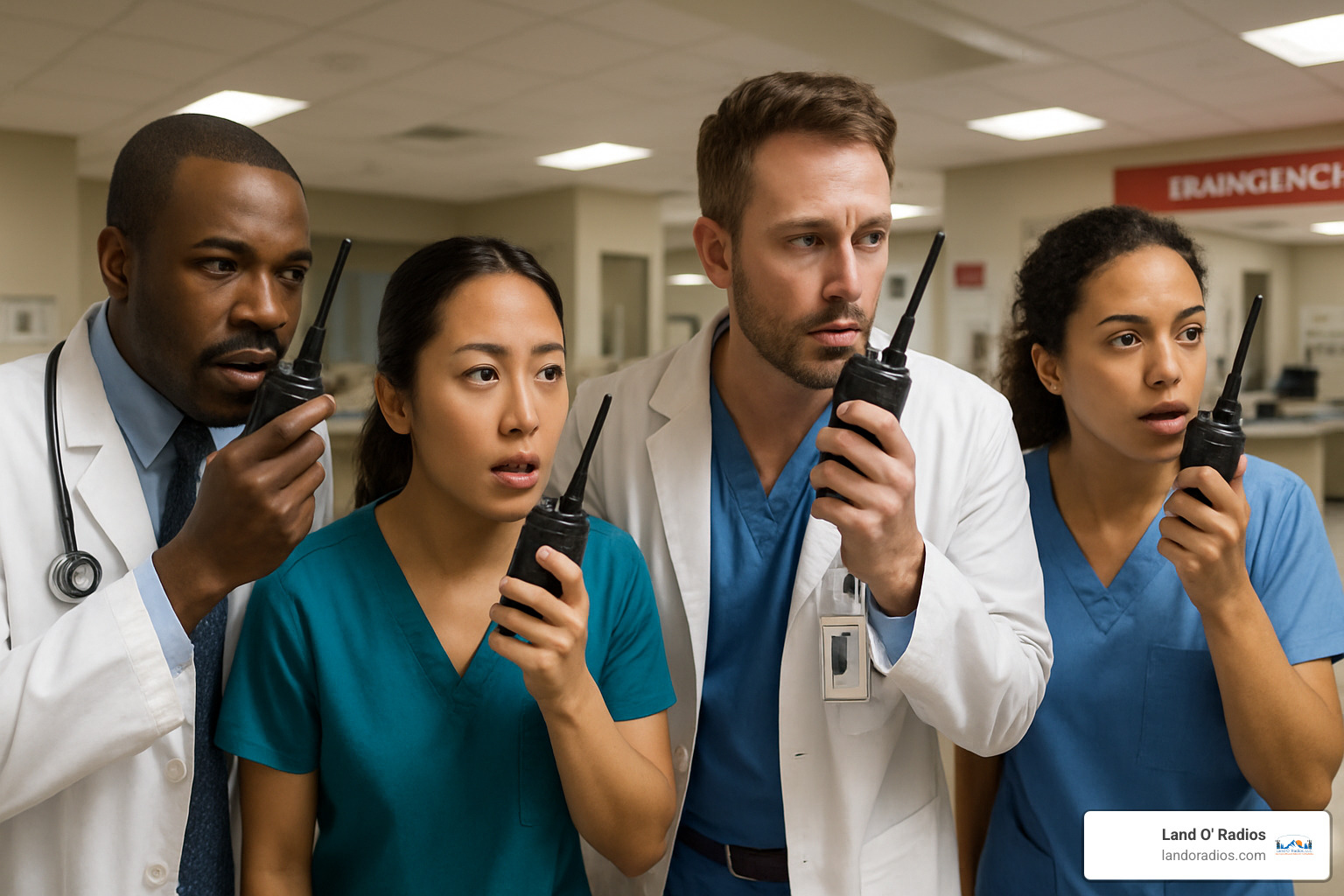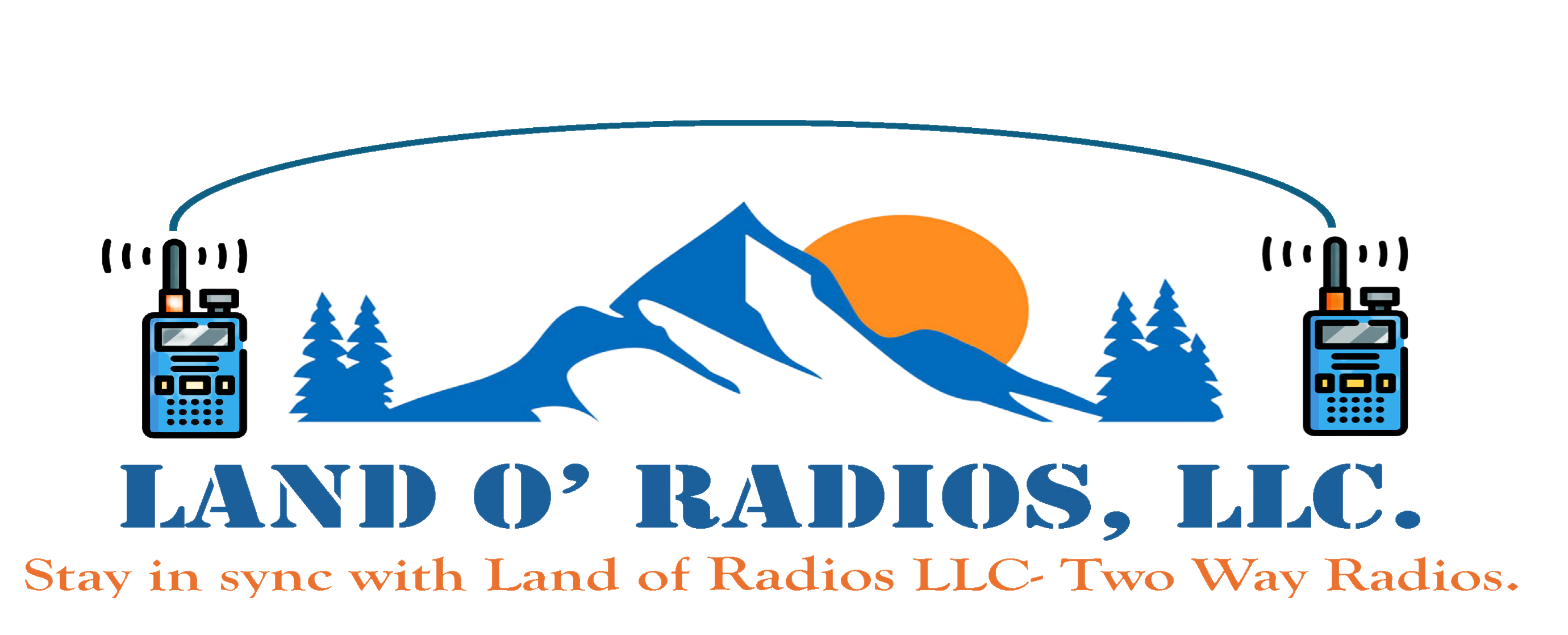Why Healthcare Radios Are Essential for Modern Medical Facilities

Healthcare radios are specialized two-way communication devices designed for medical environments, enabling instant voice communication between doctors, nurses, and support staff while maintaining patient privacy and infection control standards.
Top Healthcare Radio Features:
- Antimicrobial coatings to prevent germ spread
- HIPAA-compliant privacy with earpiece accessories
- Long battery life (up to 24 hours operation)
- Indoor coverage up to 300,000 sq ft or 20 floors
- Hands-free operation with VOX capability
- Emergency alert buttons for instant all-staff notifications
In healthcare settings, every second counts. When a patient collapses in the waiting room or an emergency situation unfolds, traditional communication methods like phones or pagers create dangerous delays. Healthcare radios solve this problem by providing instant, reliable communication that can reach entire teams with the push of a button.
Medical offices using two-way radios report that these devices quickly pay for themselves through increased efficiency and turnaround times. Unlike consumer walkie-talkies, healthcare-specific radios feature antimicrobial housings, privacy codes for HIPAA compliance, and specialized accessories like earpieces that prevent patient information from being overheard.
The technology has evolved far beyond basic voice communication. Modern healthcare radios integrate with nurse call systems, provide indoor location tracking, and offer Wi-Fi connectivity for expanded coverage. Digital models eliminate FCC licensing fees while providing encrypted channels that protect sensitive patient data.
I'm Rene Fornaris, Vice President of Land O' Radios, with over ten years of experience in two-way radio communications through my work at Advanced Radio Systems. My expertise in healthcare radios comes from helping medical facilities nationwide implement communication systems that improve patient care while maintaining regulatory compliance.
Why Two-Way Communication Matters in Healthcare
When a patient's heart stops beating or a medical emergency unfolds, every second truly matters. In these critical moments, the difference between a successful outcome and a tragedy often comes down to how quickly medical teams can communicate and coordinate their response.
Healthcare radios eliminate the dangerous delays that plague traditional communication methods. While pagers require time-consuming callbacks and phones may ring unanswered in busy hospital corridors, two-way radios provide instant voice contact that reaches the right people immediately. There's no waiting, no phone tag, and no missed messages when lives are on the line.
The impact goes far beyond emergency situations. Daily healthcare operations become remarkably more efficient when staff can instantly coordinate patient transfers, request supplies, or manage visitor inquiries through radio communication. This improved coordination translates directly into better patient satisfaction scores and more effective use of precious healthcare resources.
Medical facilities using healthcare radios consistently report significant cost savings that go beyond the obvious elimination of monthly cellular fees. The real savings come from faster bed turnover, reduced overtime costs, and improved workflow optimization that allows healthcare workers to focus on patient care rather than hunting down colleagues.
Modern digital radios incorporate sophisticated privacy protection through scientific research on frequency-hopping privacy technology. This advanced encryption makes healthcare radio communications virtually impossible to intercept, addressing the patient confidentiality concerns that are paramount in medical environments.
How healthcare radios cut response times
The magic happens when healthcare radios integrate seamlessly with existing nurse call systems. When a patient presses their call button, the alert instantly broadcasts to all available nursing staff through their radios. Instead of one nurse rushing from across the facility, the closest available team member can respond immediately.
All-call alerts represent one of the most powerful features available in healthcare radio systems. During code situations or facility-wide emergencies, pressing a single button mobilizes the entire team simultaneously. This capability proves invaluable when every healthcare worker needs to know about a critical situation instantly.
Task delegation becomes effortless with radio communication. Supervisors can assign duties, request supplies, or coordinate patient care activities without abandoning their current responsibilities. This real-time coordination keeps healthcare workflows moving smoothly and eliminates the frustrating delays associated with traditional communication methods.
Safety & privacy gains for patients and staff
Healthcare workers face unique safety challenges, and healthcare radios provide crucial protection through discreet panic buttons. When staff encounter threatening situations, they can activate these emergency alerts instantly, ensuring rapid security response while maintaining their personal safety.
Patient privacy concerns disappear with properly configured encrypted channels. Digital healthcare radios employ proprietary frequency hopping technology that makes conversations virtually impossible for unauthorized personnel to intercept. This addresses HIPAA compliance requirements that many healthcare facilities worry about when considering wireless communication devices.
The strategic use of earpieces with healthcare radios ensures that sensitive patient information remains completely private. When staff receive radio communications through earphones, there's no risk of unauthorized personnel overhearing confidential medical discussions in hallways, elevators, or patient areas.
Key Features to Demand in Healthcare Radios
Choosing the right healthcare radios isn't just about finding any communication device – it's about selecting equipment that can literally save lives while keeping your facility compliant and your staff safe. After working with medical facilities for over a decade, I've seen how the wrong radio choice can create more problems than it solves.
The most critical feature you absolutely cannot compromise on is antimicrobial housing. Regular radios are basically germ magnets in healthcare settings. Every time staff handle these devices, they risk spreading infections between patients and departments. Healthcare-specific radios feature specialized coatings that actively fight bacterial and mold growth, turning your communication device from a potential health hazard into a safety tool.
Battery endurance becomes a matter of life and death during long shifts and emergency situations. I've heard too many stories about radios dying at the worst possible moment – right when a code blue is called or during a critical patient transfer. The best healthcare radios deliver up to 24 hours of continuous operation, ensuring your communication lifeline stays active even during the most demanding situations.
Coverage range varies dramatically based on your facility's size and construction materials. Small medical offices typically need coverage up to 200,000 square feet or about 15 floors, while large hospital complexes require systems that can penetrate 300,000 square feet or 20 floors of concrete and steel. Digital radios consistently outperform analog alternatives when it comes to indoor coverage, especially in challenging building environments.
Privacy codes and encryption protect your patients and your facility from HIPAA violations. These features ensure that sensitive medical conversations stay private while preventing unauthorized access to confidential communications. Without proper encryption, you're essentially broadcasting patient information to anyone with a scanner.
Wi-Fi and cellular fallback capabilities extend your communication reach beyond traditional radio limitations. These hybrid systems ensure staff can maintain contact when working in dead zones or traveling between facilities. It's like having a backup communication system built right into your primary device.
Noise-cancelling accessories make the difference between clear communication and dangerous misunderstandings. Hospital environments are incredibly noisy – from medical equipment alarms to emergency vehicles. High-quality earpieces and speaker microphones with noise-cancelling technology ensure critical messages get through clearly, even during the busiest moments.
For comprehensive guidance on getting your team comfortable with these devices, check out our training best practices for new users.

Must-have specs for "healthcare radios"
The weight of your healthcare radios directly impacts staff comfort and compliance. I've seen facilities invest in great communication systems only to have staff avoid using them because the radios were too heavy or bulky. The best healthcare radios weigh less than 3 ounces – light enough that staff forget they're wearing them during 12-hour shifts.
Discreet wearables help maintain the professional appearance that patients expect from healthcare providers. Compact radios can be worn unobtrusively under clothing or clipped to medical scrubs without creating bulk or looking unprofessional. Some models weigh just 2.38 ounces and feature slim profiles that practically disappear when worn.
Hands-free VOX capability becomes essential when staff need to communicate while providing patient care or wearing medical gloves. This Voice Operated Exchange feature activates the radio's microphone automatically when the user speaks, eliminating the need to press buttons for transmission. It's particularly valuable during sterile procedures or when hands are occupied with patient care activities.
Ensuring HIPAA compliance with radios
HIPAA compliance isn't optional in healthcare – it's the law. When implementing healthcare radios, you must have specific protocols in place to protect patient privacy, or you risk facing serious legal and financial consequences.
Earphones represent your first line of defense against HIPAA violations. When staff use earpieces, radio transmissions can't be overheard by unauthorized personnel, visitors, or other patients. High-quality earphones also provide clearer audio, reducing the risk of miscommunication during critical patient care situations. It's a simple solution that solves multiple problems at once.
Talk-group segregation allows you to create separate communication channels for different departments or staff roles. This segmentation ensures that sensitive patient information only reaches authorized personnel who need that information for patient care. Emergency department staff don't need to hear routine housekeeping communications, and housekeeping doesn't need access to sensitive medical discussions.
Audit logging capabilities in advanced healthcare radios provide the documentation you need to demonstrate compliance with privacy regulations. These logs track when communications occur, which staff members participate, and what channels are used for different types of information. It's like having a digital paper trail that proves your facility takes patient privacy seriously.
Best Healthcare Radios in 2025 – Top Picks & Technologies
The landscape of healthcare radios has evolved significantly, with new technologies offering unprecedented capabilities for medical communication. Understanding the different options available helps healthcare facilities make informed decisions about their communication infrastructure.
Digital DMR (Digital Mobile Radio) technology represents the gold standard for healthcare communication. These systems provide superior audio quality, extended battery life, and advanced features like text messaging and GPS tracking. DMR radios can integrate with existing hospital systems and provide the reliability that healthcare environments demand.
Push-to-Talk over Cellular (PoC) solutions extend communication coverage to nationwide networks, making them ideal for healthcare systems with multiple locations or staff who travel between facilities. These systems combine the instant communication benefits of traditional radios with the coverage advantages of cellular networks.
Wi-Fi hybrids offer the best of both worlds, providing traditional radio communication within facilities while extending coverage through Wi-Fi networks. These systems are particularly valuable for large hospital complexes where traditional radio coverage may be limited in certain areas.
Repeaters amplify radio signals to extend coverage throughout large facilities or across multiple buildings. Healthcare facilities with complex layouts or multiple floors often require repeater systems to ensure reliable communication in all areas.
"Healthcare radios" for small clinics
Small medical practices have unique communication needs that differ significantly from large hospital systems. Single-channel radios often provide sufficient functionality for small clinics where all staff members need to communicate on the same channel.
License-free digital radios eliminate the ongoing costs and regulatory requirements associated with traditional radio systems. These devices operate on digital frequencies that don't require FCC licensing, making them cost-effective solutions for small healthcare practices.
Long battery life is particularly important for small clinics where staff may not have dedicated support personnel to manage radio charging and maintenance. The best healthcare radios for small practices provide 12-24 hours of operation on a single charge.
"Healthcare radios" for multi-building hospitals
Large healthcare systems require sophisticated communication solutions that can handle high call volumes and provide coverage across multiple buildings and campuses. Trunked DMR systems offer the scalability and reliability that these environments demand.
PoC nationwide coverage ensures that healthcare staff can communicate regardless of their location, whether they're working in the main hospital, satellite clinics, or traveling between facilities. This capability is particularly valuable for healthcare systems with multiple locations.
Indoor location tracking helps healthcare facilities monitor staff locations and optimize response times for patient care activities. This technology can automatically route communications to the nearest available staff member, improving efficiency and patient satisfaction.

| Technology | Range | Privacy | Cost | Licensing |
|---|---|---|---|---|
| Analog | Up to 5 miles | Basic privacy codes | Low initial cost | FCC license required |
| Digital DMR | Up to 20 floors/300k sq ft | Encrypted channels | Moderate cost | FCC license required |
| Push-to-Talk Cellular | Nationwide | End-to-end encryption | Monthly subscription | No license required |
Implementation, ROI & Maintenance Tips
Getting healthcare radios up and running in your medical facility isn't just about buying the equipment and handing it out. The most successful implementations start with thoughtful planning that considers your unique facility layout, staff workflows, and communication needs.
Think of deployment planning as creating a roadmap for success. You'll want to walk through your facility and identify communication dead zones, understand how your staff moves throughout their shifts, and determine which departments need to talk to each other most frequently. This groundwork makes the difference between a system that transforms your operations and one that sits unused in a storage closet.
The real magic happens when your healthcare radios work seamlessly with your existing systems. Modern radio systems can talk to your nurse call system, fire alarms, and mass notification platforms, creating a unified communication hub that makes your entire facility safer and more efficient.
Staff training is where many facilities stumble, but it doesn't have to be complicated. Most healthcare workers pick up radio operation quickly when they see how it improves their daily work. The key is showing them the benefits rather than just explaining the buttons. For comprehensive training strategies, check out our radio vs walkie-talkie differences guide.
Healthcare environments require special attention to cleaning protocols for radios. These devices need regular sanitization between users, but they also need to keep working reliably. The good news is that healthcare-grade radios are designed to handle frequent cleaning with approved disinfectants.
Don't overlook accessory management – those earpieces, chargers, and belt clips are essential for daily operations. Having a system to track and maintain these items prevents the frustration of dead batteries or missing accessories when staff need them most.
Funding strategies for radio systems vary widely. Some facilities prefer capital purchases for long-term ownership, while others benefit from leasing arrangements that include maintenance and upgrades. The best approach depends on your budget cycles and technology refresh policies.
Integrating radios with existing hospital systems
Modern healthcare radios shine brightest when they're connected to your existing infrastructure. When a patient presses their call button, imagine that alert going directly to the radio of the nearest available nurse, not just to a central station where someone has to relay the message.
Fire alarm integration takes safety to the next level. Instead of relying on overhead speakers that might not be heard in noisy areas, emergency alerts can reach every staff member instantly through their personal radio. This is particularly valuable in patient rooms where traditional alarms might be muffled.
Mass notification dashboards give administrators powerful tools for facility-wide communication. Whether it's a weather emergency, security alert, or important policy update, you can reach every staff member simultaneously with the push of a button.
Calculating payback period & hidden savings
Here's where healthcare radios really prove their worth financially. While the upfront investment might seem significant, these systems typically pay for themselves within 6-18 months through a combination of direct savings and operational improvements.
The most obvious savings come from eliminating monthly cellular fees. Unlike smartphones or other communication devices that require ongoing service plans, two-way radios operate on your own frequencies with no recurring charges. For a facility with 50 staff members, that's potentially thousands of dollars saved annually.
Reduced phone expenses add up quickly when staff use radios for internal communication instead of tying up phone lines. This is especially valuable during busy periods when phone systems can become overwhelmed with internal calls.
The biggest hidden benefit is faster bed turnover. When housekeeping can instantly notify nursing that a room is ready, and nursing can immediately alert admissions, beds become available sooner. This improved efficiency directly translates to increased revenue potential and better patient satisfaction scores.
Long-term upkeep for healthcare radio fleets
Maintaining your healthcare radios doesn't require a dedicated IT team, but it does need consistent attention to keep everything running smoothly. Battery rotation is probably the most important ongoing task – nothing undermines confidence in a communication system like dead batteries during critical moments.
Firmware updates keep your radios current with the latest features and security improvements. Most modern systems make this process straightforward, often allowing updates to be pushed out automatically during off-peak hours.
Sanitation best practices have become even more important in recent years. Healthcare-grade radios are designed to withstand frequent cleaning, but following manufacturer guidelines ensures your devices stay functional while meeting infection control requirements. Some facilities use disposable covers or barrier films when radios are shared between staff members, which can extend device life while maintaining hygiene standards.
The key to successful long-term maintenance is establishing clear procedures and making someone responsible for oversight. This doesn't have to be a full-time job, but having a designated person ensure batteries are rotated, firmware is updated, and cleaning protocols are followed makes all the difference in system reliability.
Frequently Asked Questions about Healthcare Radio Deployments
Do radios interfere with medical equipment?
This is probably the most common concern we hear from healthcare facilities, and I completely understand why. The good news is that modern medical equipment is built with RF shielding technology that prevents interference from two-way radios. You can safely use healthcare radios throughout your facility without worrying about disrupting critical medical devices like monitors, ventilators, or life-support equipment.
The secret lies in choosing the right radios for your environment. Professional-grade healthcare radios are specifically designed to coexist peacefully with medical equipment. These devices undergo rigorous testing to ensure they meet electromagnetic compatibility standards that protect both your communication system and your medical devices.
When we help healthcare facilities select their radio systems, we always consider the specific medical equipment in use and recommend radios that operate on appropriate frequencies and power levels. This careful selection process eliminates interference concerns while providing reliable communication capabilities.
How do we keep patient conversations private over radio?
Patient privacy is absolutely critical, and healthcare radios offer several effective ways to protect sensitive information. The most straightforward approach is requiring your staff to use earpieces for all radio communications. This simple step prevents unauthorized personnel from overhearing confidential patient information.
Digital radios take privacy protection even further with encrypted channels that secure conversations from interception. These systems use advanced encryption algorithms that make it virtually impossible for unauthorized users to access patient communications, even if they have radio equipment.
The key to maintaining privacy is establishing clear protocols for radio use. Your staff needs to understand what information can be transmitted over radio channels and what communications require more secure methods. Training your team on HIPAA compliance for radio communications ensures everyone knows how to protect patient privacy while benefiting from instant communication capabilities.
What departments benefit the most from radios?
While every department can benefit from better communication, some areas see more dramatic improvements than others. Emergency departments typically experience the most immediate benefits because they require instant communication for critical patient care situations. When seconds count, radio communication enables rapid response to emergencies and efficient coordination of trauma care.
Nursing departments are close behind in terms of benefits. Nurses constantly need to coordinate patient care activities, request supplies, and communicate with other departments throughout their shifts. Healthcare radios eliminate the need to leave patient bedsides to make phone calls or send messages, keeping nurses focused on patient care.
Security departments rely heavily on radio communication to coordinate responses to incidents, monitor facility access, and communicate with law enforcement when necessary. The instant communication capabilities of radios are particularly valuable for security applications where quick response times are essential.
Don't overlook your maintenance and housekeeping departments either. These teams use radios to coordinate cleaning activities, respond to spill notifications, and manage facility maintenance tasks. Radio communication helps these departments respond quickly to requests and maintain smooth facility operations.

Conclusion
The evidence is clear: healthcare radios are no longer a luxury but a necessity for modern medical facilities. Whether you're running a small clinic or managing a sprawling hospital complex, these specialized communication devices create the instant connections that can literally save lives.
Think about it – when every second counts in a medical emergency, the difference between fumbling for a phone and pressing a radio button can mean everything. The healthcare radios we've explored throughout this guide don't just improve communication; they transform how medical teams work together, respond to crises, and care for patients.
The financial benefits speak for themselves too. Most facilities see their radio systems pay for themselves within the first year through reduced phone costs, improved efficiency, and faster patient turnover. But the real value goes beyond dollars and cents – it's about creating an environment where staff can focus on what they do best: providing exceptional patient care.
At Land O' Radios, we've spent years understanding exactly what healthcare facilities need from their communication systems. We don't just sell radios; we partner with healthcare organizations to find solutions that fit their unique challenges. Our curated selection focuses on the devices that actually work in real healthcare environments, not just the ones with the fanciest marketing.
Every healthcare facility is different, and that's why we take the time to understand your specific needs. Are you dealing with infection control challenges? We'll help you find radios with antimicrobial coatings. Need HIPAA compliance? We'll set you up with encrypted systems and proper earpiece accessories. Managing a multi-building campus? We'll design a system that keeps everyone connected.
The future of healthcare communication isn't complicated – it's about having the right tools to connect the right people at the right time. Healthcare radios provide that foundation, creating communication networks that grow with your facility and adapt to your changing needs.
Ready to see how the right radio system can transform your healthcare operations? We're here to help you steer the options and find the perfect solution for your team. After all, better communication means better patient care, and that's what we're all working toward.
For more information about selecting the best communication solutions for your organization, explore our comprehensive guide to the best commercial radios for every need.








